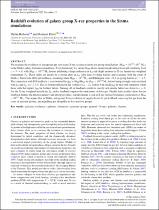| dc.contributor.author | Robson, Dylan | |
| dc.contributor.author | Dave, Romeel | |
| dc.date.accessioned | 2023-06-26T12:58:20Z | |
| dc.date.available | 2023-06-26T12:58:20Z | |
| dc.date.issued | 2023 | |
| dc.identifier.citation | Robson, D., & Dave, R. (2023). Redshift evolution of galaxy group X-ray properties in the SIMBA simulations. Monthly Notices of the Royal Astronomical Society, 518(4), 5826–5842. https://doi.org/10.1093/mnras/stac2982 | en_US |
| dc.identifier.issn | 1365-2966 | |
| dc.identifier.uri | https://doi.org/10.1093/mnras/stac2982 | |
| dc.identifier.uri | http://hdl.handle.net/10566/9154 | |
| dc.description.abstract | We examine the evolution of intragroup gas rest-frame X-ray scaling relations for group-sized haloes (M500 = 1012.3–1015 M)
in the SIMBA galaxy formation simulation. X-ray luminosity LX versus M500 shows increasing deviation from self-similarity from
z = 3 → 0, with M500 < 1013.5 M haloes exhibiting a large reduction in LX and slight increase in X-ray luminosity-weighted
temperature TX. These shifts are driven by a strong drop in fgas with time for these haloes, and coincides with the onset of
SIMBA’s black hole (BH) jet feedback, occurring when MBH > 107.5 M and Eddington ratio <0.2, in group haloes at z ∼ 1.5.
The connection with BH feedback is corroborated by fBH ≡ MBH/M500 in M500 < 1013.5 M haloes being strongly anticorrelated
with LX and fgas at z 1.5. This is further reflected in the scatter of LX − TX: haloes with small fBH lie near self-similarity, while
those with the highest fBH lie furthest below. Turning off jet feedback results in mostly self-similar behaviour down to z = 0.
For the X-ray weighted metallicity ZX, stellar feedback impacts the enrichment of halo gas. Finally, halo profiles show that jet
feedback flattens the electron density and entropy profiles, and introduces a core in X-ray surface brightness, particularly at M500
< 1013.5 M. This argues that in SIMBA, intragroup X-ray evolution is largely driven by jet feedback removing hot gas from the
cores of massive groups, and expelling gas altogether in less massive groups. | en_US |
| dc.language.iso | en | en_US |
| dc.publisher | Oxford University Press | en_US |
| dc.subject | Astronomy | en_US |
| dc.subject | Physics | en_US |
| dc.subject | Galaxies formation | en_US |
| dc.subject | Galaxy evolution | en_US |
| dc.title | Redshift evolution of galaxy group X-ray properties in the SIMBA simulations | en_US |
| dc.type | Article | en_US |

